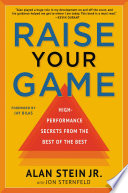

The book emphasizes the importance of having the right mindset for achieving success. A growth mindset, characterized by resilience, adaptability, and a willingness to learn from failures, is crucial. This mindset allows individuals to embrace challenges, persist through difficulties, and view effort as a path to mastery. The author provides strategies to cultivate this mindset, including setting clear goals, visualizing success, and maintaining a positive outlook. By fostering a growth mindset, individuals can unlock their potential and improve their performance in various aspects of life.
Continue readingDiscipline is highlighted as a key component of high performance. The book argues that talent alone is not sufficient; consistent practice and self-discipline are essential for achieving excellence. The author outlines techniques for building discipline, such as creating routines, establishing accountability, and prioritizing tasks. By developing discipline, individuals can overcome procrastination, stay focused on their goals, and make steady progress toward their ambitions.
Continue readingEmotional intelligence (EQ) is presented as a critical skill for effective leadership and collaboration. The book explains the components of EQ, including self-awareness, self-regulation, empathy, and social skills. The author emphasizes that high EQ enables individuals to manage their emotions, understand others' feelings, and navigate social complexities. Strategies for enhancing emotional intelligence include active listening, practicing empathy, and seeking feedback. By improving EQ, individuals can build stronger relationships and lead more effectively.
Continue readingThe importance of surrounding oneself with a supportive network is a central theme in the book. The author discusses how relationships with mentors, peers, and coaches can provide guidance, encouragement, and accountability. Building a diverse network allows individuals to gain different perspectives and insights, which can enhance decision-making and problem-solving. The book offers tips for networking effectively, such as being genuine, offering value to others, and nurturing relationships over time.
Continue readingThe book stresses the necessity of lifelong learning in a rapidly changing world. The author argues that staying relevant and competitive requires a commitment to ongoing education and skill development. This can include formal education, self-study, or experiential learning opportunities. The book provides practical advice on how to create a personal learning plan, set learning goals, and seek out resources. By embracing continuous learning, individuals can adapt to changes in their fields and maintain a competitive edge.
Continue readingGoal setting is presented as a foundational element of high performance. The author explains the importance of setting SMART (Specific, Measurable, Achievable, Relevant, Time-bound) goals and visualizing success. Visualization techniques can help individuals clarify their objectives and mentally prepare for challenges. The book includes exercises for effective goal setting and visualization, encouraging readers to create a roadmap for their aspirations. By having clear goals and a vision, individuals can stay motivated and focused on their journey.
Continue readingResilience and adaptability are emphasized as essential traits for overcoming obstacles and thriving in uncertainty. The book discusses how setbacks and failures are inevitable but can serve as valuable learning experiences. The author provides strategies for building resilience, such as reframing negative thoughts, practicing gratitude, and developing coping mechanisms. By cultivating resilience and adaptability, individuals can navigate challenges with confidence and emerge stronger from adversity.
Continue reading